Traffic in India has become a growing concern that affects the daily lives of citizens. With more people and vehicles on the roads, it’s no surprise that congestion is now a common sight in major cities in the country. Long travel times, frustrating delays, and the impact on businesses are just some of the challenges faced by citizens.
A reliable ANPR for India is needed. In this article, we elaborate on the need for ANPR in India as well as the unique challenges to high-accuracy ANPR for Indian license plates. We also share some specific examples of how we have tuned our ANPR algorithms to support the beautiful country of India.
What is ANPR?
Automatic Number Plate Recognition (ANPR), also known as Automatic License Plate Recognition (ALPR), is software used to recognize the number plates automatically by performing sophisticated optical character recognition on images to read the license plates of vehicles.
A typical ANPR solution takes an image as input and returns the decoded vehicle plate, timestamp and confidence level of the decoding algorithm. The image is analyzed in as fast as 20 to 50 milliseconds to enable real-time surveillance.
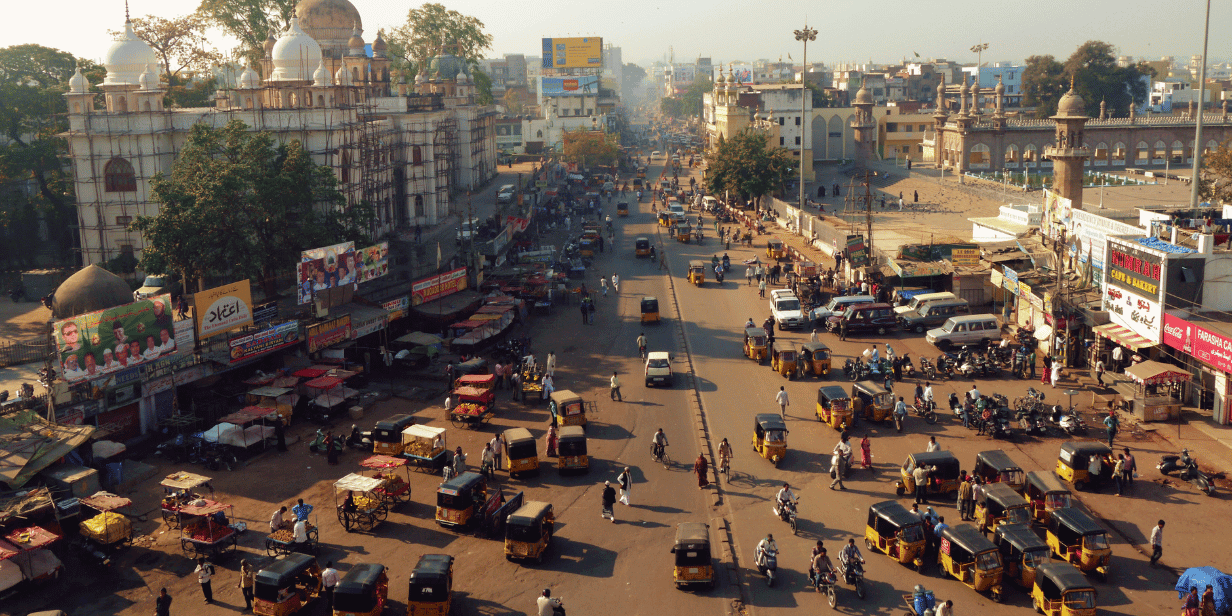
Hyderabad in India. Source: Canva
Two Cities in India Made It to the Top 10 List of Cities with the Most Traffic
Two cities from the country have unfortunately found their way into the top 10 of the TomTom Traffic Index Ranking of 2022. Bengaluru, also known as Bangalore, has secured the second spot on the list.
Commuters in Bengaluru now face an average travel time of 29 minutes and 10 seconds per 10 kilometres, which is 40 seconds longer compared to the previous year. This persistent increase in travel time has a significant impact on the lives of citizens, who find themselves spending a staggering 260 hours stuck in rush hour traffic each year. These delays not only cause frustration but also affect businesses, as valuable time is wasted on the road.
Another city affected by the worsening traffic conditions is Pune, which has been repeatedly recognized as the most liveable city in India. Unfortunately, Pune has made it to the list at number 6 in the TomTom Traffic Index Ranking. The average travel time per 10 kilometres in Pune has risen to 27 minutes and 20 seconds, surpassing the previous year by a substantial 1 minute and 10 seconds.
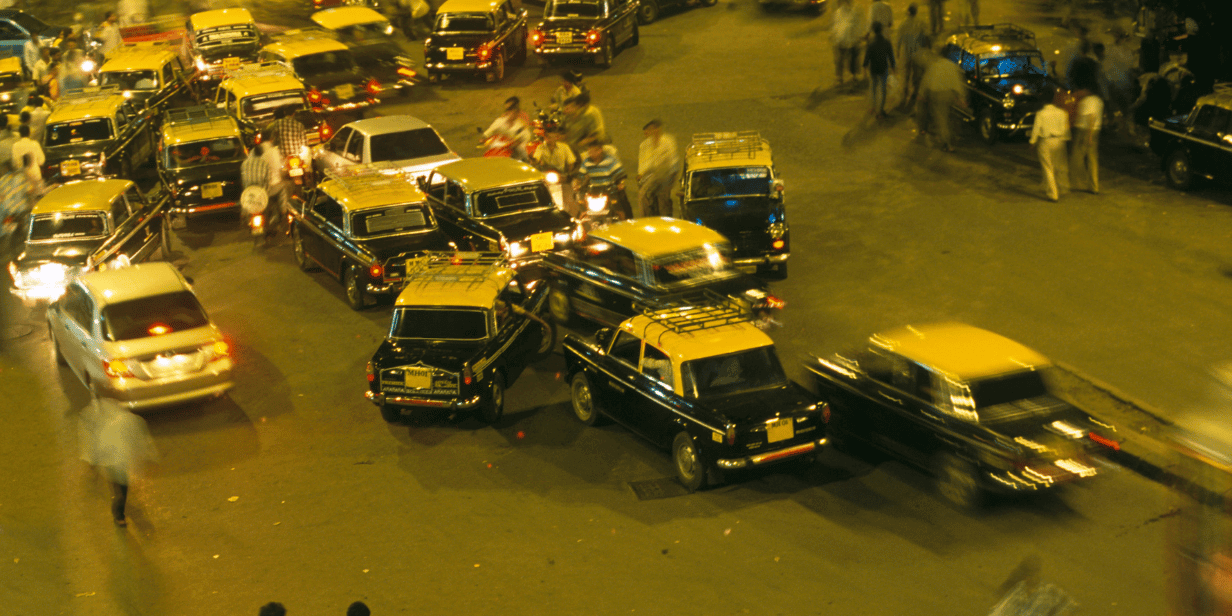
Mumbai Taxi Cabs in Traffic. Source: Canva
This significant increase adds to the difficulties faced by citizens, who now spend around 249 hours stuck in rush hour traffic annually. The impact on their daily lives is significant, as they struggle to reach their destinations on time.
By investing in improved transportation infrastructure, implementing smarter traffic management systems with the use of ANPR for India, and promoting alternative modes of transportation, it’s possible to alleviate the traffic conditions that affect both citizens and businesses.
What is ANPR?
Automatic Number Plate Recognition (ANPR), also known as Automatic License Plate Recognition (ALPR), is software used to recognize the number plates automatically by performing sophisticated optical character recognition on images to read the license plates of vehicles.
A typical ANPR solution takes an image as input and returns the decoded vehicle plate, timestamp, and confidence level of the decoding algorithm. The image is analyzed as fast as 20 to 50 milliseconds to enable real-time surveillance.
Need for ANPR in India
Unlike other countries, India, with its one billion people population, has a unique set of needs for ANPR. The main use of ANPR for India is in highway monitoring, parking management, and neighbourhood law enforcement security.
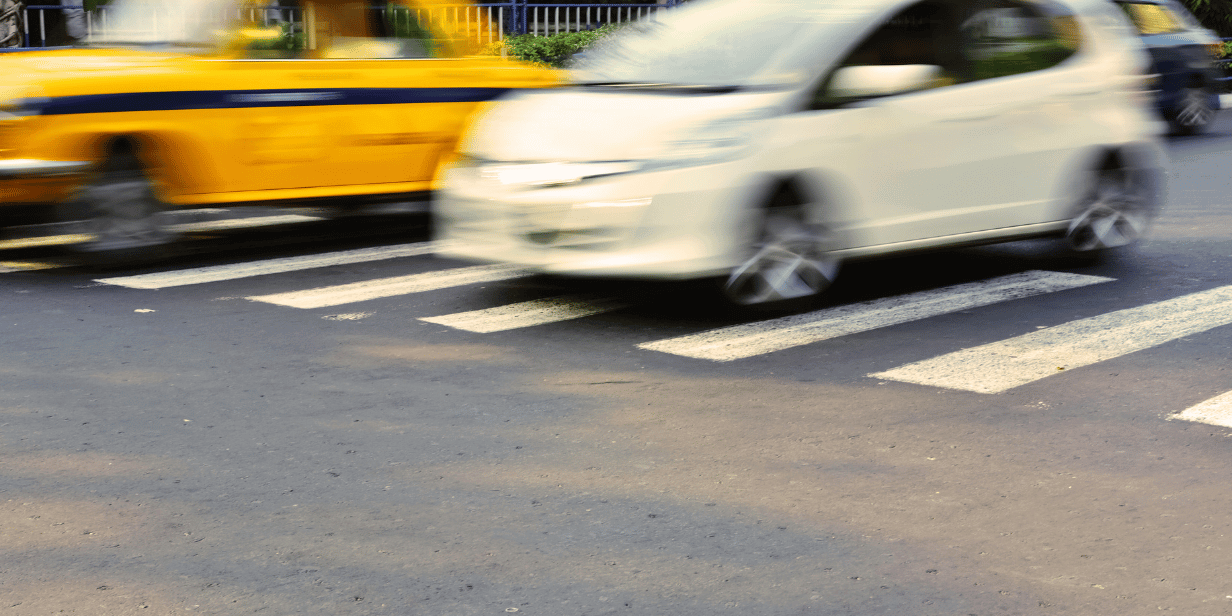
Speeding Car and Taxi on the Road. Source: Canva
In 2022, there were 1,55,622 recorded road traffic deaths in India. 59.7% of those fatalities were due to overspeeding. ANPR technology can be used to monitor the vehicles’ average speed and can identify the vehicles that exceed the speed limit.
In this case, a fine ticket can be automatically generated by calculating the distance between two cameras. This helps to maintain law and order which, in turn, can minimize the number of road casualties.
When it comes to parking management, ANPR for India provides the best solution. Vehicles with registered plates can automatically enter parking areas while non-registered vehicles will be charged by the time of check-in and check-out. The number plates of the car can be directly linked with the owner’s mobile phone and parking tickets could be paid without any extra effort directly from the user’s account against the ticket number generated. ANPR can support a cloud-based system pre-book and pre-pay platform for parking.

Thief Attempting to Open a Car Door. Source: Canva
Security-wise, did you know that in India about 100,000 cars are stolen per year? Just like traffic, car theft has also become a major problem but this number can lessen if proper steps are taken and an ANPR system is used to track cars. Then, law enforcement can identify when, where and the route taken by a stolen vehicle. This can help bring justice swiftly to such a vast nation.
ANPR Challenges in India
The need for ANPR in India is strong but one of the major challenges of the technology is the types of number plates in India. ANPR in countries such as Australia, Vietnam and Italy, which have fairly standardized license plates, have accuracy levels often exceeding 90%.
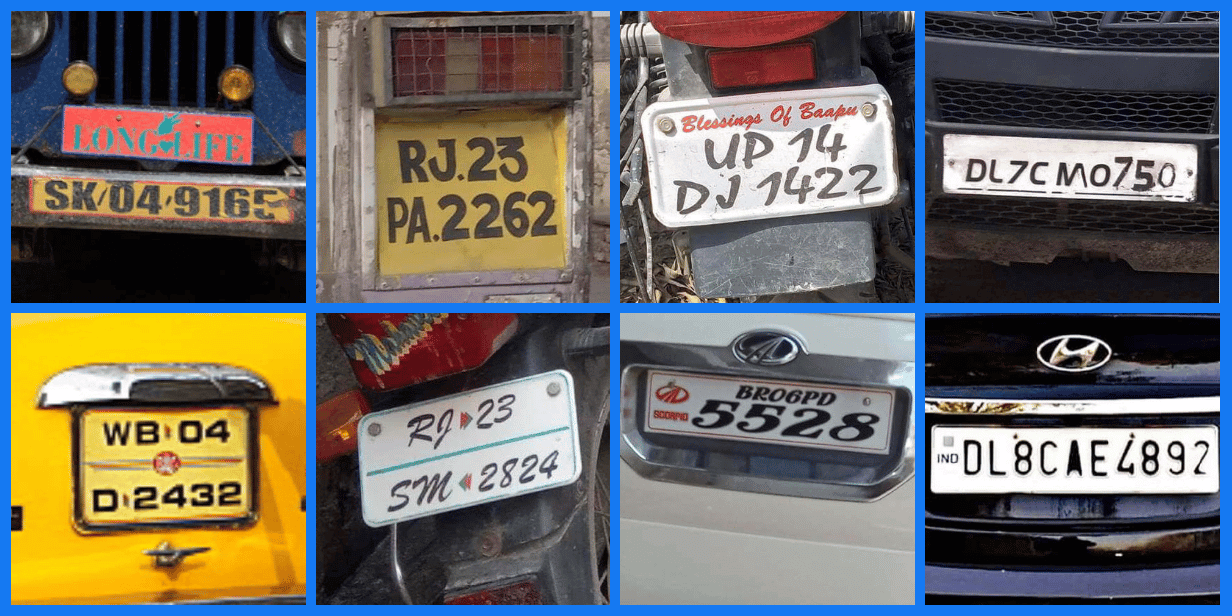
India license plates are as diverse as the country itself–lots of styles, colours, fonts, sizes, etc. Source: Plate Recognizer Clients.
India, however, is quite different. The variations in Indian license plates make it difficult for an ANPR system to accurately identify and decode the license plate. There are 210 million vehicles with over 50 different types of number plates in India. The plates vary in colour, text and even location in the vehicle. For example, certain regions of India would have certain plate formats and certain generations of vehicles have their unique peculiarities.
Moreover, cameras deployed in India tend to be of lower quality, thereby compounding the ability of ANPR engines to accurately decode the license plate. The low-cost cameras have limited visual coverage, are equipped with less acute motion and object detection sensors, and contain limited night vision capabilities. These three factors increase the number of blind spots and the occurrence of blurry images. This situation is made worse during nighttime and inclement weather when visibility is lower.
As such, ANPR for India’s accuracy rates seldom exceed 70% from our internal analysis of our competitive ANPR providers. This is an entirely different story for our Germany ANPR and UK ANPR software.
Types of Number Plates in India
Number plates in India come in a variety of types, each serving a specific purpose and carrying its own distinctive features.
1) White number plates
White number plates are commonly seen on non-commercial vehicles, such as personal cars and motorcycles. They typically display a series of letters and numbers indicating the state code, district code, and vehicle registration number.
2) Yellow number plates
Yellow number plates are exclusively used for commercial vehicles like taxis, buses, and trucks. The yellow colour helps distinguish them from private vehicles. These plates also follow a specific format, starting with a state code, followed by digits and the registration number, with the addition of a “TA” code to denote a taxi in some cases.
3) Green number plates
Green number plates have a special significance as they are reserved for electric vehicles (EVs). These plates have a green background with white lettering and an emblem of a white lotus with green petals and a plug at the centre. Only fully electric and certain hybrid vehicles meeting specific criteria are eligible for these plates, granting them benefits and incentives provided by the government.
4) Red number plates
Red number plates in India are assigned to vehicles going through temporary registration or used for testing purposes. These plates indicate that the vehicle hasn’t received a permanent registration number yet and are typically seen during transit, demonstrations, or testing phases.
5) Blue number plates
Blue number plates are exclusive to vehicles owned by foreign diplomatic missions, such as embassies or consulates. These plates, issued by the Ministry of Foreign Affairs, have white letters and numbers, often accompanied by a logo or emblem indicating the country of origin or diplomatic status.
6) Black number plates
Black number plates are specifically designated for self-driven rental cars used for commercial purposes. These plates differentiate rental vehicles from private ones and may vary in usage and regulations across different states.
5) Number plate with an upward arrow
Finally, a number plate with an upward-pointing arrow signifies vehicles belonging to the armed forces. This plate is reserved for the army, navy, air force, and other branches of the Indian armed forces. These vehicles often receive certain privileges and exemptions from regular traffic rules.
Additionally, there are red number plates in India with the emblem of the country, exclusively used for government-owned vehicles operated by central or state governments. These plates feature the national emblem, signifying their official status.
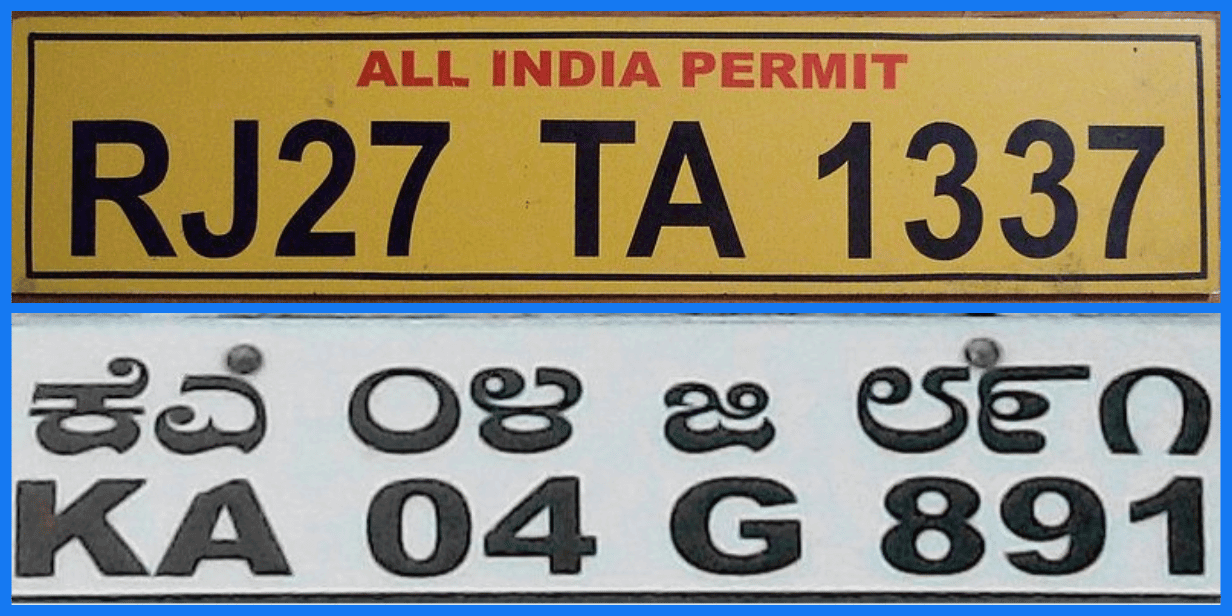
Different Types of Number Plates in India. Source: Wiki Commons
Characters in Number Plates in India
As for the characters or text on number plates in India, the components can vary depending on the location of the vehicle registration. The first two letters on the plate represent the state or union territory code, providing information about where the vehicle is registered. Following the state code, the next set of characters represents the RTO (Regional Transport Office) or district code, indicating the specific jurisdiction within the state.
After the state and district codes, the remaining six characters on the number plate consist of a combination of two alphabets and four numbers. This unique code is assigned to each vehicle during the registration process and serves as its individual identification.
The diverse range of number plate types in India reflects the various categories of vehicles and their specific purposes. While this system helps to ensure effective identification, regulation, and differentiation on the roads, it can be challenging for an ANPR engine to accurately decode the number plates.
Plate Recognizer Improvements for India ANPR
We at Plate Recognizer appreciate the importance of ANPR for India. After building our “global” ANPR solution, we focused our efforts on improving Indian number plate recognition, since we received quite a lot of interest from developers. Little did we know, though, about the all challenges mentioned above for the India license plate recognition market.
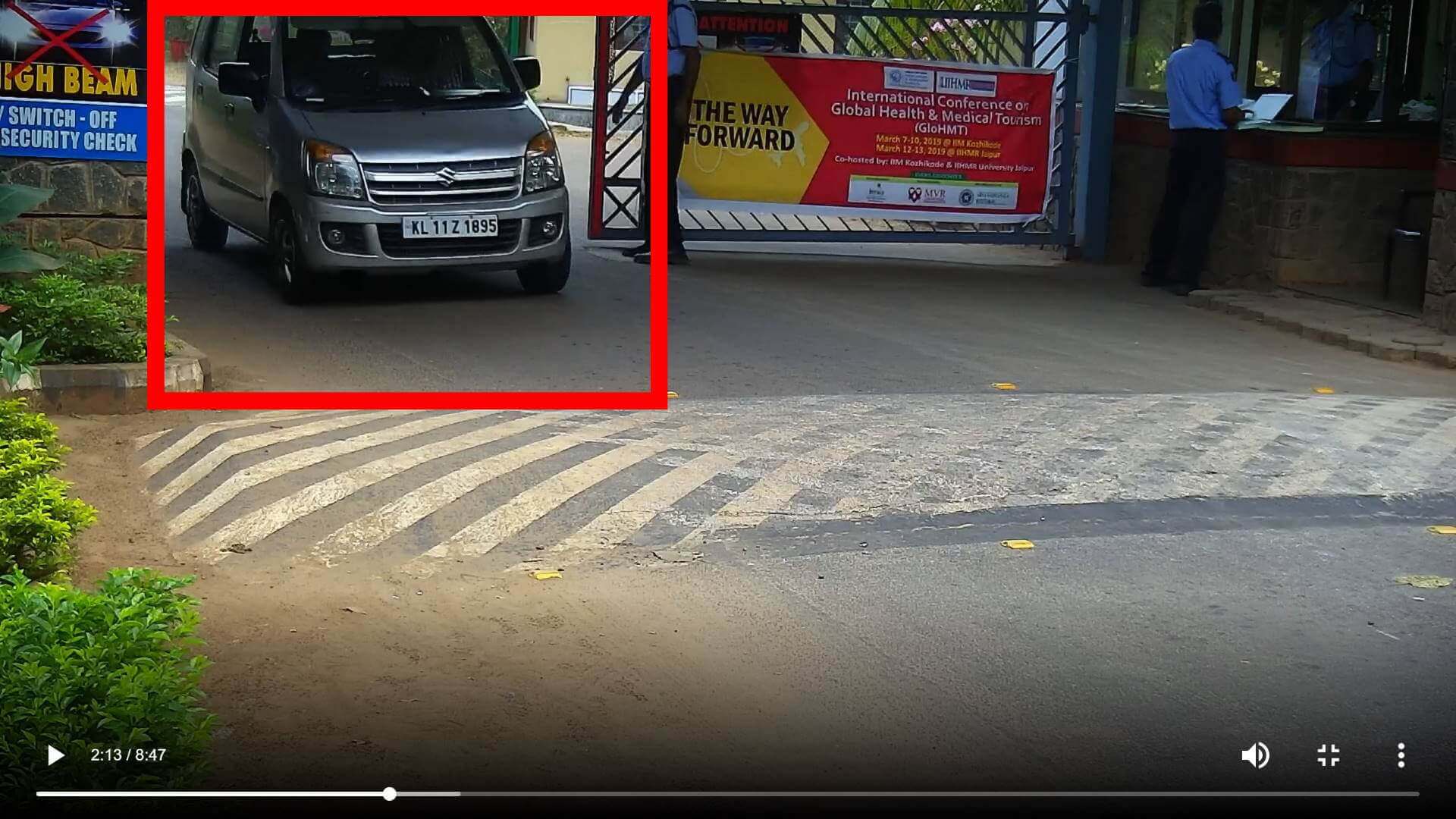
Rather than focusing camera on entire region, ANPR can be improved by focusing camera towards the red box highlighted above. Source: Plate Recognizer Client.
Here is our 5-step process to improve India ANPR:
DEFINE LICENSE PLATE VARIATIONS. We began our journey by spending a lot of time assessing all the license plate variations across the different regions of India. We learned that the plates were as diverse as the people groups, languages and cultures within the country!
CREATE REGEX. For each license plate variation, we created the plate’s regex (tech term for regular expression). We also analyzed and defined the font type and font size of each license plate type.
GET SAMPLE IMAGES OF INDIA LICENSE PLATES. Thanks to our partners in India, we received and manually processed thousands upon thousands of images of real-life India license plates and fed that into our ANPR engine. The images contained mopeds, motorcycles, aged vehicles, new sedans, station wagons, minivans, light-weight trucks, semi-trailer trucks, flatbed trucks, buses and more.
ANALYZE LICENSE PLATE PATTERNS. Our plate recognition engine matched the regex to each plate type and image. This allowed us to “educate” the engine with specific parameters that pertain to that vehicle and plate type.
ASSESS IMPROVEMENTS. Once a pattern has been established, we reran the base images through the ANPR engine to see what improvements were realized.
Over the course of several months, we iterated each day and found small, but encouraging improvements to the ANPR accuracy rates. Little by little, plate by plate, we inched up the ladder.
As we saw the improvements, we applied our global set of algorithms to compensate for the photo quality and lighting conditions. This allowed our number plate recognition engine to improve its accuracy for low-resolution, blurry and dark images.
After months of intense work, we were able to take our ANPR accuracy rates to upwards of 90%. Depending on the environment and situation (e.g. parking lot in the city centre), our customers are seeing over 95% ANPR accuracy for India.
Other Ways to Improve ANPR
In addition to enhancing the underlying ANPR engine for India, we have made some concrete suggestions to help our customers achieve high-accuracy ANPR with Plate Recognizer.
ADJUST MOTION DETECTION. Depending on the camera and/or Video Management Software (VMS) used, we see images where the vehicle is barely visible. This may be due to the fact that the motion detection is too sensitive or that the camera and/or VMS is capturing the image right when motion is detected. Fixing this issue is easy: just set a slight delay in the image capture. So rather than immediately capturing the image, wait 0.5 seconds for the vehicle to be more prominent. This way, the number plate can be more present in the photo for the ANPR engine.
FOCUS CAMERA. It is important to focus the ANPR camera on the incoming vehicle plate. We often see cameras in front of parking lots that aim wide across the parking lot rather than towards the entrance or exit areas. Again, the fix is simple: just adjust the camera position and width of focus so that the license plate can be more present.
PROPER LIGHTING. We have made great inroads with our ANPR engine to decode license plates in dark environments. However, in some situations, clients share images with us where the headlights make it impossible to even detect that a plate is present. To fix this, you’ll need to brighten the entrance/exit points or use a camera with a higher aperture.
While the suggestions above pertain to all countries, not just India, they can significantly improve accuracy rates for ANPR if implemented correctly.
Huge Opportunities for ANPR in India
As India goes through a phase of modernization and infrastructure development in the upcoming decade, we see significant opportunities for various government entities, municipalities, and businesses to embrace ANPR.
In the meanwhile, we will continue to invest in our ANPR engine specifically tuned for India so that we can make it better and better!
If you would like to test drive our ANPR software, you can do so for free by signing up for an account today.
You Can Help!
Are you working on an ANPR project for India? If so, you can help!
With more vehicle images, we can continue to tune the engine to address your use case for ANPR. Just send us 5,000 to 10,000 vehicle images via Dropbox or FTP. Together, we can make ANPR for India stronger and stronger. Contact us for more info.